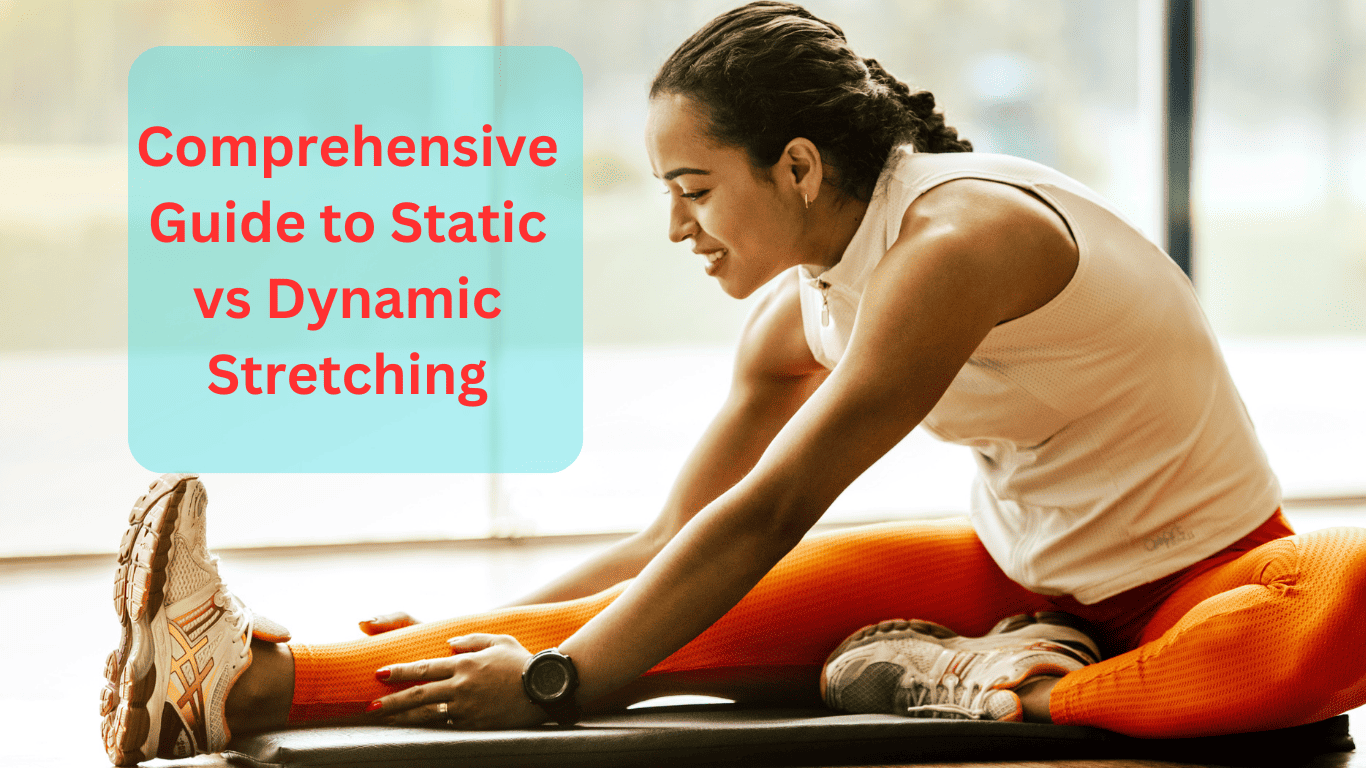A Comprehensive Guide to Static vs Dynamic Stretching: Benefits + Examples

Are you getting ready for a workout? If yes, then it’s probably a good idea to take a few minutes for stretching.
However, you may wonder, what type of stretching will give you the most benefits before starting your workout?
To help you answer this question, let’s take a comprehensive look at static vs dynamic stretching. While both types of stretching are important, they have different benefits and pros and cons.
So keep reading to get a better understanding of which method is the best for you and your warm-up routine. By the end of this post, you’ll be equipped with all the information you need to make an informed decision. So, let’s dive in!
What Is Static Stretching?
Static stretching is commonly used as a recovery tool for athletes and fitness enthusiasts alike. This type of stretching involves holding a particular position for 15 seconds to 1 minute without any movement.
Static stretches help muscles to relax and lengthen, increasing flexibility and range of motion. They are also a great tool to use after a workout to cool down and prevent injury.
Compared to other types of stretching, such as dynamic stretching, static stretches are considered passive stretching movements. In essence, this means that the muscles are not contracting or exerting any force during the stretch, which allows for a more comfortable and controlled stretch.
By incorporating static stretching into your fitness routine, you can help improve your overall flexibility and mobility.
What Is Dynamic Stretching?
Dynamic stretching is a type of active stretching that is great for warming up before exercising. It involves performing a series of controlled movements that mimic the motion of the activity you are about to do.
This type of stretching uses momentum to help increase flexibility and range of motion in the body. Dynamic stretching can help prepare your muscles and joints for the physical demands of the upcoming activity, reducing the risk of injury.
Dynamic stretches can be done before almost any type of exercise, and they are an effective way to get your heart rate up and your body ready to move. With dynamic stretching, you can take your workouts to the next level!
Related Post: 7 Essential HIIT Treadmill Workout for Beginners
What Are the Benefits of Stretching?
Based on the study “Current Concepts In Muscle Stretching for Exercise and Rehabilitation” by Phil Page, For an effective warm-up, it is advisable to perform dynamic stretches. Conversely, static stretches are more suitable for post-exercise to prevent a decline in strength and performance during the workout.
Dynamic Stretching
- Helps improve blood flow
- Loosen up the muscles before the activity
- Injury Prevention
- Improve Performance
- Increase Heart Rate
Static Stretching
- Can help reduce muscle stiffness
- Ease soreness after a workout.
- Shorten recovery days
- Improve flexibility
- Injury Prevention
More importantly, regular stretching routines before and after exercise can help enhance both athletic performance and overall flexibility. Indeed, incorporating stretching into your daily routine can have a significant impact on your physical abilities.
What Is the Difference Between Static vs Dynamic Stretching?
Stretching is an essential part of any workout routine. However, properly identifying and using the correct stretching method can make all the difference.
Static and dynamic are two common stretching methods, but they work differently.
Static stretches involve holding a position for an extended period, whereas dynamic stretches involve moving through a full range of motion.
While both methods improve flexibility and prevent injury, static stretches are better suited for after a workout, while dynamic stretches should be used as a warm-up.
Choosing the right stretching method for your workout can enhance your performance, and improve your overall fitness.
Examples of Static Stretches and Dynamic Stretches
Static Stretching Routine
Adding static stretching to your fitness routine is important. Holding a position for 30 seconds helps flexibility and muscle lengthening. After workouts, static stretches aid in quicker recovery and prevent injuries by enhancing flexibility.
- Pigeon Post Stretch
- Cat & Cow Stretch
- Figure “4”
- Hamstring Stretch
- Doorway Pec Stretch
- Calf Stretch
Dynamic Stretching Routine
Dynamic stretching mimics the movements you’ll be doing in your workout. It lengthens and engages the targeted muscles, increasing flexibility and range of motion. Stretching before a workout is essential for a safe and productive session. It replicates the movements you’ll perform, improving flexibility and preventing injuries. Use a general routine before any exercise.
- Step Forward Lunges
- Side Step Lunges
- Forward Leg Swings
- Cat & Cow Stretch
- High Knee
- Butt Kicks
- Arm Circles
- Fire Hydrants (Side Leg Raises)
What Are the Precaution of Static and Dynamic Stretches?
Stretching is an essential component of any workout routine, whether it’s static or dynamic. Although both types of stretches offer different benefits, it’s crucial to be cautious while performing them to avoid any potential injuries.
Static stretching involves holding a muscle in a stretched position for a certain amount of time, while dynamic stretching requires movement through a full range of motion. Overstretching during a static stretch can cause muscle strain.
Dynamic stretching done too quickly can lead to sprains or other injuries. Therefore, it’s important to know your body’s limits, warm up properly, and maintain proper form while performing both types of stretches.
With these precautions in mind, incorporating a combination of static and dynamic stretching can greatly improve flexibility and reduce the risk of injury during physical activities.
Conclusion
Incorporating stretching into your workout routine is essential for preventing injuries, enhancing performance, boosting flexibility, and improving recovery time.
By following the instructions, you can determine when to perform dynamic and static stretches. It’s important to warm up adequately, stretch gradually and smoothly, and be mindful of your physical limits.
Implementing these precautions can elevate your workout performance and assist you in achieving your fitness objectives.
Disclaimer: The information provided in this blog post is for educational and informational purposes only and should not be construed as medical advice or a substitute for professional medical guidance, diagnosis, or treatment. Always consult with a qualified healthcare professional before starting any exercise program or making changes to your current routine. The author and publisher of this blog post are not responsible for any adverse effects, injuries, or consequences resulting from the use or misuse of the information provided. The reader assumes full responsibility for any actions taken based on the information presented in this blog post.
FAQ
Is dynamic or static stretching better?
It is important to incorporate both dynamic and static stretching into your fitness routine. Dynamic stretching, which involves pre-workout movements to warm up the body and improve the range of motion, can be very helpful. On the other hand, post-workout static stretching can aid in enhancing flexibility and minimizing the risk of injury.
Is Static Stretching Better Than Dynamic for Flexibility?
Both static and dynamic stretching can be beneficial for improving flexibility. A dynamic stretch is great for a pre-workout routine to improve muscle flexibility during your exercise. While Static stretching helps to improve the overall elasticity of the muscle fibers in post-workout routines.





